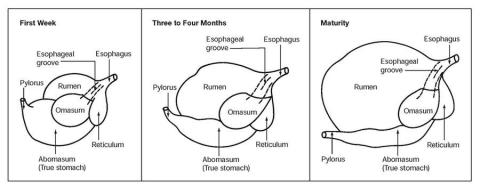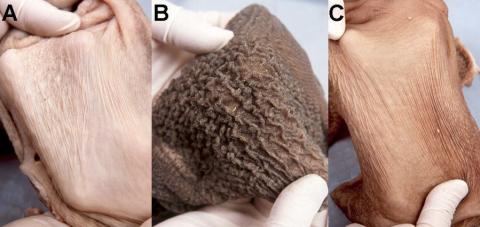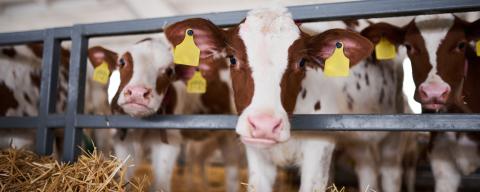Feeding calves properly is one of the most important steps to raising healthy, productive animals. After the initial feeding of colostrum [5], calves move into a new stage with different nutritional needs. This phase is essential for calves to grow strong, stay healthy, and prepare for solid feed.
Nutrient Requirements for Calf Growth
Calves require a balanced diet containing energy, protein, fiber, vitamins, and minerals for optimal growth and development:
- Energy: Energy is vital for the growth and maintenance of body functions. During the milk-feeding phase, energy is provided by milk or milk replacer, which contains lactose and fat. As calves transition to solid feeds, grains in the starter feed become the primary source of energy [10].
- Protein: Protein is essential for muscle growth and overall development. High-quality proteins from milk replacers, skim milk powder, or whey protein are easily digestible by young calves. As calves begin consuming starter feed, protein content remains crucial—starter feeds with 18-26% crude protein are recommended to support growth [9].
- Fiber: Fiber is important for stimulating rumen motility and overall digestive health. Although young calves do not need large amounts of fiber early on, a small amount in the starter feed helps stimulate rumination and saliva production, which buffers rumen pH and supports rumen function.
- Vitamins and Minerals: Vitamins and minerals are vital for various metabolic processes. Fat-soluble vitamins (A, D, E, K) and some water-soluble vitamins (B-complex) are required. Minerals such as calcium, phosphorus, and trace elements like zinc and copper are also essential for skeletal growth, muscle function, and immune health.
Digestive System and Rumen Development
At birth, a calf’s digestive system functions similarly to that of a simple stomach animal (Fig 1). The abomasum, or “true stomach” is the main site for digestion during this stage. The rumen, reticulum, and omasum have not yet been developed enough to play significant roles in digestion. In addition to calf growth, rumen development (Table 1) is a primary goal of calf nutrition and is stimulated by the introduction of starter feed, water, and forage. Microbes that enter the rumen through feed and the environment begin to break down carbohydrates in the starter feed, producing volatile fatty acids (VFAs) like butyrate, propionate, and acetate. Butyrate is particularly effective in stimulating the growth of rumen papillae - small, finger-like projections that increase the surface area for nutrient absorption [2].
Milk Feeding
Milk or milk replacer is the main source of nutrition for calves during their first weeks of life. The “traditional” milk rate was recommended at 8 to 10% of body weight (BW), however, higher feeding rates of 12 to 20% BW are often fed. Calves with ad libitum access to milk will consume close to 20% BW in milk. This means that a 100 lb. Holstein will consume between 4.6 quarts and 9 quarts daily. As the calf’s BW increases, milk consumption should also increase.

© 2025 The Penn State Research Foundation - used by permission
Figure 1. Development of Rumen from birth to maturity.
extension.psu.edu/feeding-the-newborn-dairy-calf
Several types of milk can be used to feed calves:
- Whole Milk: Whole milk contains a balanced combination of proteins, fats, lactose, and essential vitamins.
- It is the most natural form of milk feeding and provides all the necessary nutrients to support early calf growth.
- Readily available on farms and supports strong early growth.
- Feeding waste milk, or milk that cannot be sold from sick cows or cows treated with antibiotics, is not recommended.
- Proper handling is necessary to avoid pathogen transmission. Pasteurization is recommended to prevent the spread of diseases like Johne’s or Salmonella.
- Milk Replacer: Milk replacer is a powdered alternative designed to mimic much of the nutritional profile of whole milk. It typically contains 20-28% crude protein and 10-22% fat.
- Milk replacers are often fortified with vitamins (A, D, E) and minerals (calcium, phosphorus, magnesium).
- Milk replacers provide a consistent supply of nutrients.
- Milk replacer can be formulated with milk or with plant alternatives, and the quality may vary.
- Transition Milk: Transition milk, produced during the 2nd to 4th milkings after calving, bridges the gap between colostrum and regular milk, offering essential nutrients and bioactive compounds needed for calf development.
- Transition milk is rich in proteins, fats, vitamins, and residual antibodies that support immunity, gut health, and growth.
- Like whole milk, proper handling is essential, and pasteurization is recommended.
| Stage | Age | Rumen Development | Recommended Feed1 | Implications |
|---|---|---|---|---|
Neonatal Phase | Birth to 3 days | Rumen is undeveloped. Milk digestion occurs in the abomasum (true stomach). | Colostrum (first 24 hours). Whole milk or milk replacer. | Essential for immunity and survival. No rumen activity yet. |
Transition Phase | 3 to 14 days | Rumen begins to develop slowly. Limited microbial activity starts. | Milk or replacer. Small amounts of calf starter introduced. Fresh water. | Starter feed stimulates papillae growth. Water supports microbial activity. |
Development Phase | 2 to 4 weeks | Rumen size and microbial population increase. Papillae growth progresses. | Milk or replacer. Starter offered ad libitum. Fresh water. | Rumen begins digesting some solids. Starter feed enhances rumen development. |
Weaning Preparation | 4 to 8 weeks | Rumen becomes functional. Microbial populations diversify. Increased fermentation efficiency. | Gradual milk reduction. Starter feed as primary diet. Small amounts of high-quality hay introduced. | Starter feed drives rumen development. Limited hay aids digestion without reducing starter intake. |
Weaning Phase2 | 8 weeks to weaning | Rumen is fully functional. Efficient digestion of solid feeds. | Starter feed as the primary diet. Limited high-quality hay. | Calves are ready for full weaning. Proper feeding ensures sustained growth and health. |
Table 1. Rumen Development from birth to weaning.
1The “traditional” milk rate was recommended at 8-10% of BW, however higher feeding rates of 12-20% BW are often fed. Calves with ad libitum access to milk will consume close to 20% BW in milk. This means that a 100 lbs. Holstein will consume between 4.6 quarts and 9 quarts daily. As the calf’s BW increases, milk consumption will increase. As milk consumption (%BW) increases, starter consumption will decrease.
2Calves consuming higher milk feeding rates will require a long weaning phase than calves consuming “tradition-al” milk feeding rates.

© 2025 The Penn State Research Foundation - used by permission
Figure 2. Comparison of rumen papillae development at 6 weeks in calves fed milk only (A), milk and grain (B), or milk and hay (C).
extension.psu.edu/feeding-the-newborn-dairy-calf
Starter Feed and Rumen Development
Starter feed is vital for the calf’s development of rumen (Figure 2). Calf starters promote the production of volatile fatty acids (VFAs) through carbohydrate fermentation. Butyrate, a key VFA, encourages papillae growth, which enhances nutrient absorption [9].
Starter feeding recommendations:
- Starter should be introduced by day 3
- Fresh starter should be given daily
- Calf starter should contain 18-26% protein to support microbial growth and rumen activity
- During weaning, starter intake should increase as milk consumption decreases
- Calves should consume at least 2 lbs. of starter daily for 3 consecutive days before they are fully weaned
Commercial calf starters typically include grains, proteins, vitamins, minerals, and fiber to meet the nutritional demands of growing calves. Ingredients like corn, soybean meals, and processed grains are frequently used due to their high digestibility and energy content. Research emphasizes the importance of processed grains such as steam-flaked corn in improving digestibility and promoting weight gain [7].
The physical form and texture of starter feed are also important. Textured feeds, which mix grains and roughage, are often more palatable, encouraging higher intake. Pelleted feeds, on the other hand, prevent feed sorting and ensure uniform nutrient intake but may not appeal as much to calves [1].
Hay Feeding
While it is not essential before weaning, hay can help stimulate rumination, which increases saliva production. Saliva acts as a natural buffer, helping to stabilize rumen pH and reducing the risk of acidosis. However, hay alone does not provide sufficient fermentable carbohydrates to stimulate papillae development effectively (Figure 2), as its fermentation primarily produces acetic acid. This is less beneficial for papillae growth compared to butyrate, which is derived from the fermentation of starter feeds containing grains [2]. Additionally, hay can reduce average daily gain because it lacks the concentrated nutrients needed for optimal growth [8]. Hay should be introduced once the calf consistently consumes an adequate amount of starter, or fed carefully based on the following recommendations[11]:
- Calves fed textured starter and bedded on chopped straw may have reduced ADG with hay
- Calves fed pelleted starters and not bedded with straw should be fed some chopped forage
- Alfalfa should be no more than 10% of dry matter intake
- Other forages can be fed ad libitum or included in starter or TMR at no more than 5% of total dry matter
Importance of Water
Access to fresh, clean water is important for rumen development. Water helps create an environment in the rumen suitable for microbial fermentation, which is essential for VFA production. It also encourages calves to eat more starter feed by making it easier to digest. Water should be provided from the first week of life, as it plays an essential role in hydration and supports overall digestion [6].
Transition to Solid Feed and Weaning
Weaning typically occurs between 6 and 8 weeks of age, depending on the calf's intake of solid feed. Before weaning, calves should consistently consume at least 2 pounds of starter feed per day for 3 consecutive days. Gradually reducing milk while increasing starter feed intake allows the rumen to adapt and fully develop the microbial populations needed to digest fibrous feedstuffs effectively. Proper weaning management helps avoid nutritional stress and promotes continued growth. Weaning strategies can include:
- Reducing the amount of milk fed at each feeding
- Reducing the number of milk feedings offered
- Watering down milk at each feeding
Conclusion
Calf nutrition is essential to promote adequate growth and rumen development needed for future milk production. By focusing on milk intake, early introduction of starter feed, careful addition of hay, and providing adequate water, producers can support healthy rumen development, better feed efficiency, and improved growth rates. This balanced approach leads to healthier calves, better performance during weaning, and a more productive dairy herd.
References
1Bach, A., Giménez, A., Juaristi, J. L., & Ahedo, J. (2007). Effects of physical form of a starter for dairy replacement calves on feed intake and performance. Journal of Dairy Science. https://www.sciencedirect.com/science/article/pii/S0022030207701169
2Heinrichs, A. J., & Lascano, G. J. (2009). Rumen development and health for optimal growth and rumen microbial production in dairy replacements. Proceedings of the 7th Western Dairy Management Conference, Reno, Nevada, USA, March 11-13, 2009, pp. 127-138.
3Jones, C. M., & Heinrichs, J. (2022). Feeding the Newborn Dairy Calf. https://extension.psu.edu/feeding-the-newborn-dairy-calf
4J. Heinrichs, & Jones, C. M. (2022). Photos of Rumen Development. https://extension.psu.edu/photos-of-rumen-development
5Pereira, G., & Jimenez, A. P. (2024). Maine Dairy Calf Chronicles: Colostrum Quality and Management. https://extension.umaine.edu/publications/wp-content/uploads/sites/52/2024/10/1079-Colostrum-Quality-and-Management.pdf
6Hickey, E., & Erickson, P. (2022). An Update on Water Feeding to Preweaned Calves. https://extension.unh.edu/resource/update-water-feeding-preweaned-calves
7Makizadeh, H., Kazemi-Bonchenari, M., Mansoori-Yarahmadi, H., Fakhraei, J., Khanaki, H., Drackley, J. K., & Ghaffari, M. H. (2020). Corn processing and crude protein content in calf starter: Effects on growth performance, ruminal fermentation, and blood metabolites. Journal of Dairy Science, 103(10), 9037–9053. https://doi.org/10.3168/jds.2020-18578
8Khan, M. A., Weary, D. M., & Von Keyserlingk, M. A. G. (2011). Hay intake improves performance and rumen development of calves fed higher quantities of milk. Journal of Dairy Science. https://www.sciencedirect.com/science/article/pii/S002203021100350X
9Stamey, J. L., McKeith, F. K., Janovick, N. A., & Drackley, J. K. (2021). Influence of Starter Crude Protein Content on Growth and Body Composition of Dairy Calves. Journal of Dairy Science, 104, 3082-3097.
10Van Saun, R. J. (2022). Feeding Young Dairy Calves - Management and Nutrition. MSD Veterinary Manual.https://www.msdvetmanual.com/management-and-nutrition/nutrition-dairy-cattle/feeding-young-dairy-calves
11National Academics of Sciences, Engineering, and Medicine 2021. Nutrition Requirements of Dairy Cattle: Eighth Revised Edition. Washington, DC: The National Academies Press. https://nap.nationalacademies.org/catalog/25806/nutrient-requirements-o…

Project Funding by: Northeast Dairy Business Innovation Center
Extension Services & Tools That Help NH Farmers Grow
Newsletters: Choose from our many newsletters for production agriculture
Receive Pest Text Alerts - Text UNHIPM to (866) 645-7010



